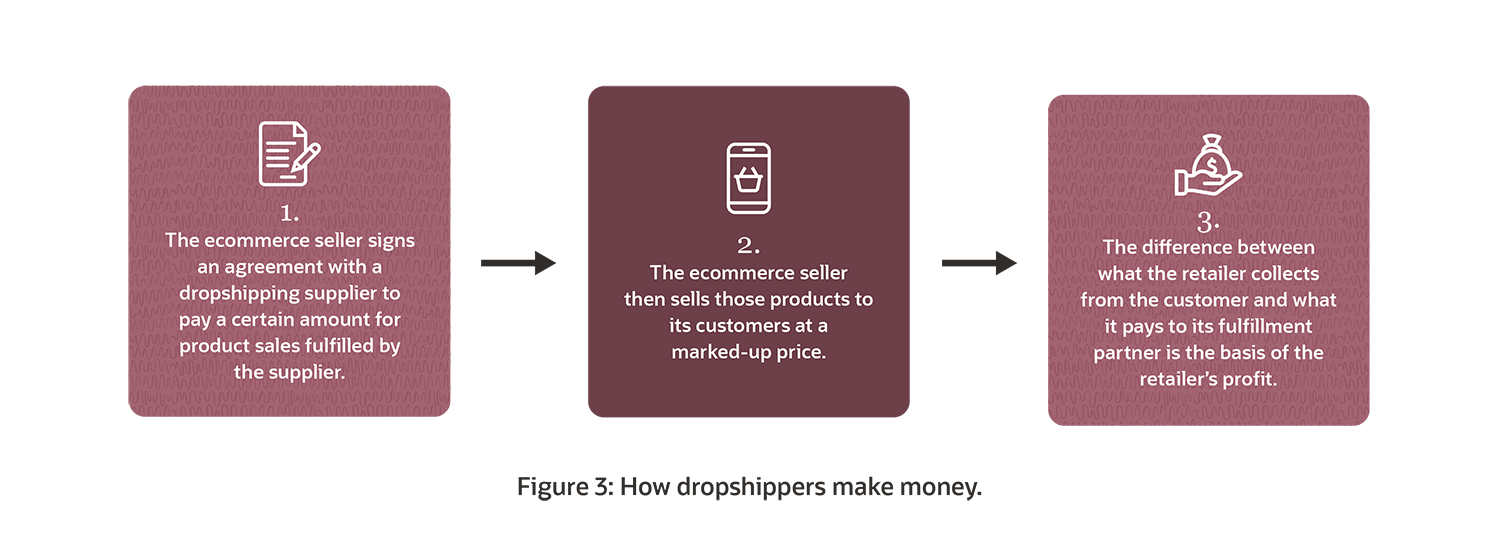In today’s hypercompetitive marketplace, retail and ecommerce companies must offer a wide variety of products that give shoppers choices. But most cannot afford to purchase and stock all those products across numerous categories, locations and selling channels.
Enter dropshipping, an order management model that allows retailers and ecommerce companies to separate sales from fulfillment. Using this model, the retailer sells the product, which is stocked and shipped to the customer by a third party, usually a wholesaler or manufacturer.
Dropshipping is a potentially cost-effective approach for ecommerce businesses. The global dropshipping market is expected to grow to $476 billion in 2026 from $129 billion in 2020, Statista reports.
What Is Dropshipping?
Dropshipping is a practice in which a retailer accepts customers’ orders but does not actually stock the goods in its warehouse or ship them to the buyer. Instead, the seller contracts with a third party — a manufacturer, wholesaler, larger retailer or fulfillment house — that maintains the inventory of products and sends them directly to customers after orders are placed. Businesses also use their own stores to drop ship orders to customers regionally.
The dropshipping model is attractive to smaller retailers and entrepreneurs because it requires relatively little capital investment and overhead. In addition to freeing a seller from managing fulfillment, dropshipping eliminates the seller’s costs for inventory, warehousing and logistics — potentially creating more profit.
Key Takeaways
- The dropshipping business model — in which retailers outsource warehousing and fulfillment — may make sense for small and midsize retailers that aren’t able to maintain warehouses and logistics infrastructures.
- Retailers that choose to fulfill orders through dropshipping minimize their capital investment and overhead costs.
- Sellers may also gain more flexibility in where they’re located and be better able to scale fulfillment processes as order volumes rise.
- Diligence in choosing products, partnerships, and processes is a prerequisite to success with a dropshipping model.
Dropshipping Explained
The service standards of Amazon and Alibaba have created an expectation of fast gratification when people shop online. But the vast majority of ecommerce players lack the expansive logistics infrastructures that these digital giants have built over decades and the means to offer so many goods. With dropshipping, ecommerce sellers can market and sell a wide variety of items without having to warehouse products or manage deliveries. It’s a way to piggyback on other companies’ infrastructures and product catalogs.
Dropshipping has its roots in the retail catalog businesses of the 1960s and 1970s. Major retailers developed high-volume mail- and phone-order businesses. These retailers used fulfillment warehouses to speed up distribution and delivery. In the 2000s, Amazon began building its own network of optimized fulfillment warehouses in a more modern version of the earlier idea.
Dropshipping became accessible to more ecommerce retailers over the last decade, when lower-cost dropshipping services emerged. Since then, the dropshipping business model has taken off.
How Does Dropshipping Work?
Retailers that opt for dropshipping outsource the order fulfillment processes — including procurement, storage and shipping — to an external dropshipping provider. The specifics of the process may depend on the type of dropshipping partner — manufacturer, wholesaler, order fulfillment provider — and the agreements and processes that are in place.
Generally speaking, however, dropshipping follows a five-step cycle:
- A dropshipping supplier sources or manufactures a product and signs an agreement with an ecommerce business.
- The ecommerce business offers that product for sale on its website, social media account, or other online platform.
- A customer places an order with the ecommerce business.
- The ecommerce business processes the order and automatically notifies the dropshipping partner of the order.
- The dropshipping partner prepares and sends the order to the buyer.

The Dropshipping Business Model
The dropshipping model enables retailers to run a low-risk, no-inventory business. There are three parties involved in the process: the customer, the retailer and the dropshipping supplier.
The retailer — also called the seller of record — contracts with a dropshipping supplier to sell the supplier’s products. The negotiated price between the retailer and dropshipping partner includes the partner’s warehousing and logistics costs. Then, when a customer places an order with the seller of record at the retail price they set, the retailer sends the order to the dropshipper to fulfill the order. The retailer keeps the difference between what its customer paid for the item and what it paid to its supplier. It’s important for the retailer to keep those numbers in mind to ensure profitability.
Working with a dropshipping partner does require some investment from the retailer, often in the form of an ecommerce and customer support platform. Retailers also incur costs for web hosting, domain names, marketing, and payment processing fees.
Why Choose the Dropshipping Business Model
Dropshipping is an attractive option for first-time online retailers due to its low overhead and flexibility. But that’s not the only time this business model makes sense. It can also prove valuable in the following scenarios:
- Testing the market. Dropshipping offers a low-cost way to conduct market research. With dropshipping, retailers can try out new products or target new customers without the large investment in inventory and warehousing that would otherwise be required.
- As a backup when things go awry. In retail, supply chain issues and changes in demand are everyday realities. In other words, they’re unavoidable. Having a dropshipping partner for backup order fulfillment can be very helpful in such situations, including when there are seasonal demand surges.
- Dealing with difficult products. Some items are simply harder to source, store and ship. This includes big, heavy, fragile, volatile, perishable, or high-value items. Working with a skilled dropshipping partner can be a more profitable way to get these items to end customers.
How to Set Up a Dropshipping Retail Business
Relative to launching a traditional retail business, setting up a dropshipping retail business can be much more straightforward. There’s little investment required to purchase inventory, set up physical infrastructure, or manage logistics. Still, there are some important steps a would-be dropshipper should take to set itself up for success.
- Find the right niche. Because dropshipping opens up the playing field for retail and lowers the barriers to entry, it’s crucial to find an opportunity with strong profit potential. Look for a product or category with high demand, few competitors, or a unique value proposition.
- Research suppliers. Reliability is the most important characteristic, but there are other factors to consider. For example, the location of a partner can have an impact on shipping speed and costs. A partner’s manufacturing capabilities, communication skills, transparency, and reputation for customer service are also important.
- Focus on ease of use and a good customer experience. Making it easy for customers to provide feedback and offering personalized communications are standard parts of most ecommerce sites today. They are among a half dozen or so steps you can take to improve the experience that users have at your store.
- Invest in marketing. When it comes to launching a dropshipping business, even if you build it, they may not come. Marketing is the key to getting customers to your site. Social media advertisements and automated email campaigns can be cost-effective approaches to building and maintaining a customer base.
- Analyze profitability and customer satisfaction. The hard work doesn’t end once orders start to come in. Just like any other company, a dropshipping retail business needs to keep tabs on its performance to ensure long-term success. Frequently measuring profitability and customer satisfaction, for example, and making changes to improve them over time is essential.

Benefits of Dropshipping
Companies and entrepreneurs looking for a low-cost way to get started in retail may consider dropshipping. Among the benefits of using dropshipping:
- Lower capital investment: Unlike the traditional retail model, which requires investments in product inventory, storage and labor, dropshipping enables individuals or organizations to start online retail businesses with minimal capital investment. They will pay these partners as items sell, but the upfront investment is far smaller.
- Decreased overhead costs: Retailers that use dropshipping do not have to source, store, ship, or directly handle returns of the products they sell. This can lower their overhead costs and the amount of work sellers are responsible for.
- Scalability: By working with a variety of manufacturers, wholesalers, or fulfillment centers, small and midsize retailers can more readily expand their businesses. As long as they can handle the additional work of payment processing and customer support, they can expand at a relatively low incremental cost.
- Geographic flexibility: With a dropshipping business model, a retailer can operate from anywhere — including the owner’s home.
- Multichannel opportunities: Retailers that implement a dropshipping business model can sell via any number of channels — their own website, social media channels, or other online retailers and marketplaces — and use dropshipping on the back end to fulfill orders regardless of where they originate.
- Lower-risk experimentation: Since dropshipping retailers don’t have to pay in advance for the products they sell, they can test out new items or market segments at a lower cost and with less risk. They’re not paying to store slow-moving inventory as it eventually becomes obsolete.
Disadvantages of Dropshipping
Despite the benefits mentioned above, dropshipping may not be the right choice for everyone. Even when it appears to be a good fit, dropshipping can present some challenges, including:
- High levels of competition: Because of the low barrier to entry, a dropshipping retailer can expect to face a lot of competition. The fight for customers may be intense.
- Differentiation challenges: It can be difficult for retailers to create a unique market position when the sourcing, management, and delivery of a product are handled — and branded — by a third party. The products being sold and delivered may be indistinguishable from those offered by other dropshipping sellers.
- Profit margin pressure: Due to the highly competitive nature of the model and the difficulty of carving out a unique niche, dropshipping retailers can find themselves competing solely on price. If businesses are forced to lower prices, that eats away at margins.
- Less control: A retailer relying on third-party product fulfillment can’t directly control product quality, fulfillment speed, or return processes. Also, that retailer may not learn about supply chain issues until it has already resulted in unhappy customers. That lack of control over issues that affect customers is a challenge. A dropshipper may be able to have some influence on its partners if it does a lot of business with them, but to some extent the retailer is always at the mercy of its fulfillment partners.
- Customer dissatisfaction: When things go wrong during order fulfillment, customers will blame the retailer from whom they made the initial purchase. The low visibility of problems and the longer time required for problem resolution can further degrade the customer experience.
Is Dropshipping Profitable?
Low margins are a risk in the dropshipping space. Because startup and overhead costs are low, competition is high. Some dropshipping retailers compete solely on price and invest little in customer service, creating pressure for other sellers to also cut their prices. Another threat to margins is a high product return rate.
On the other hand, there are situations where dropshipping can increase profitability. When products are difficult to procure, stock and ship, working with a third party decreases overhead.
In addition, traditional retailers that don’t usually choose dropshipping can use the model selectively to enter new product categories or markets. Dropshipping allows them to do so with less financial exposure — that is, without a sizable investment in inventory, warehousing or logistics.
Retailers that are able to develop profitable dropshipping businesses — whether they dropship exclusively or only in select situations — get there by completing due diligence. For example, they invest in tools that optimize their purchasing processes and customer support; among these tools are email automation, point-of-sale (POS) systems and customer relationship management (CRM) tools. With better marketing and better customer service, companies may be able to hold the line on prices and maintain expected levels of profitability.

An Example of the Dropshipping Process
To better visualize how a dropshipping business works, let’s take a look at the process for an ecommerce business that sells socks. As a first step, the retailer sets up an agreement with a dropshipping supplier to pay $5 for every pair of socks its customers purchase. It then lists those socks on its website for $7.50 — that’s a 50% markup. Once a customer places an order for a pair of socks, the sock company processes the customer’s $7.50 payment, notifies the dropshipping supplier of the sale and pays it $5. Then the dropshipper sends the socks directly to the customer. While the dropshipper handles all of the logistics, the sock company bears ultimate responsibility for all customer service and support.

Is Dropshipping Right for Your Business?
While dropshipping offers numerous benefits, it may not be the best fit for every situation. Here are some key questions to consider before deciding whether the model is appropriate for your business.
How Long Is Your Runway?
“Runway” refers to the length of time your business can operate before running out of cash. If your business has a short runway — generally speaking, less than six months of operating expenses covered by current cash reserves — dropshipping might make sense because this model does not require the kind of investments in inventory, warehousing, and related ongoing overhead costs that a traditional retail or ecommerce model demands.
How Much Control Do You Want Over Your Products?
Dropshipping limits your direct control over monitoring or guaranteeing the quality of products that go out the door because the dropshipper oversees all aspects of order fulfillment. This can be a challenge because the customer will hold your business responsible for any issues with quality. Thus, it’s important to be selective about the dropshipping partners with whom you choose to work. Pay close attention to the details of the agreement and what recourse you have should issues arise.
What Are Your Profit Margin Expectations?
By working with a dropshipper, you may be competing with many other companies that are selling identical products. This often means having to beat them on price. Unfortunately, that can lead to a race to the bottom, resulting in slim profit margins. However, this challenge can be offset with strategies aimed at attracting more website customers, which could boost sales volume and make up for the lower markup on each sale.
Will Your Customers Be OK With Slower Shipping Times?
Along with limited control over product quality, you have little control over how quickly orders get out the door and into the hands of your customers. Transit times will vary depending on the carrier and location, sometimes taking longer than the customer expects if it did not select an expedited shipping option. Make sure that customers are clear on delivery timelines when placing orders.
What Is Your Marketing Strategy?
For any ecommerce company, success hinges on getting customers who are searching for a product to your website (particularly when many other companies are selling the same items). By working with a reliable dropshipper, you can focus your efforts on marketing and, as a result of working with one, promote a wide product selection, fast shipping, and/or competitive pricing. Marketing strategies that have proved effective include search engine optimization, investing in social media content and advertisements, partnering with influencers who align with your target audience, and developing loyalty or referral programs.
Are You Equipped to Handle Customer Support?
You may be outsourcing order fulfillment, but customer support is still your responsibility. Therefore, visibility into your dropshipping partner’s order fulfillment process is essential to be able to respond to customer questions, concerns, and complaints. Proactive communication with customers, such as frequent updates on order status, can go far in building good will and trust. So can well-articulated policies, procedures, and a detailed FAQ page that includes information on shipping and delivery, returns and refunds, data and privacy policies, and how to contact customer service.
5 Dropshipping Tips & Best Practices
Dropshipping may seem like an easy way to enter the retail business, but doing dropshipping well — and profitably — takes effort, experimentation, and patience. Following are some best practices for launching a dropshipping business and improving your chances of success.
- Choose your partners wisely. It’s important to weigh multiple factors when selecting a company to fill your customers’ orders. Don’t emphasize cost at the expense of quality — an unreliable partner may cause customers to flee and never come back. For example, if you’re a home furnishings retailer, a lightbulb manufacturer that charges 25 cents more per bulb but has a stellar reputation may be more valuable in the long run than a mistake-prone partner.
- Immerse yourself in the details of your agreements. Your dropshipping contracts will cover the negotiated wholesale price. But those contracts should also cover such items as service level agreements (SLAs) for shipping times; the terms of returns, refunds, chargebacks, and handling fees; fees for missed SLAs; and sanctions for breach of contract. For that hypothetical home furnishings retailer, this would mean making sure the dropshipping partner understands what the contract says about the manufacturer’s liability should products take too long to ship, get damaged in transit, or need to be returned.
- Put experimentation and learning high on your agenda. Whether it’s a new product or a new marketing approach, take advantage of the low costs of dropshipping to learn what works and what doesn’t. Build on the successes and don’t repeat the failures. If selling lightbulbs to contractors isn’t working as you had hoped, you may want to de-emphasize that segment and shift your focus to a different set of customers — consumers, for instance.
- Invest in automation. Technology and data are essential parts of developing a dropshipping business. If there are low-cost tools for targeting customers, offering services or managing finances, take advantage of them. One tool that should certainly be explored is autonomous chatbots. Automated chat sends an immediate signal to customers that online help is available at all times if they need it.
- Have a plan for when problems arise. It’s inevitable: Your suppliers will occasionally deliver late, damaged, or incorrect products. Have processes in place for managing dissatisfied customers should your partner’s performance falter. If those lightbulbs arrive in pieces, it won’t matter whether the logistics provider ignored the label that said “fragile” or the supplier forgot to put it on; the customer will blame you and it will be your problem.
Dropshipping and Technology
Technology is integral to a successful dropshipping business, as there is a lot of coordination that must happen to pull this off. Here are the most important tools for retail dropshippers:
Email automation. When used effectively, email is one of the best forms of online advertising and can have an outsized impact on sales. Email automation based on customer behavior (such as an email to a customer who abandons a shopping cart before purchasing or offering a discount on future orders to someone who has just completed an order) can deliver significant returns.
Point-of-sale (POS) systems. One part of the buying journey dropshipping retailers do is control the online shopping experience. That’s why these businesses will benefit from an integrated ecommerce platform, especially as they grow. Such platforms can connect to point-of-sale, order management, merchandising, marketing, and customer service solutions to keep everyone on the same page. A good ecommerce platform will be connected to a company’s financial system, so it’s easy to find the numbers and reports you need.
Customer relationship management (CRM) software. A CRM system stores information, such as orders, billing and service requests, so that dropshippers can analyze the data to better understand their customers. NetSuite’s CRM solution can help retailers gather their customer data alongside other critical business information in a single place, where it can be accessed by the sales, marketing, and customer support departments.
Dropshipping has considerable appeal for retailers because of its relatively low costs and low risks. Dropshippers often face intense price competition, however, and must be comfortable with a business model that leaves some things outside of their control. That said, the right partnerships, processes, and technologies can counter many of these challenges, allowing the best dropshippers -- and the retailers they work with -- to prosper and grow.
Dropshipping FAQs
How do I start a dropshipping business?
There are several steps involved. First, start in the right place — a niche where you have a chance of winning. This could mean looking for products that are in high demand, facing low competition, or competing in an area where you have a unique strength. It’s also crucial to work with reputable partners. Finally, you’ll need to open an online store and find a way to attract customers.
Is dropshipping illegal?
No, dropshipping isn’t illegal. It’s a legitimate order-fulfillment method for retailers, as long as they comply with the regulations of the regions in which they operate.
Why is dropshipping bad?
Dropshipping isn’t inherently good or bad. It is an order fulfillment model for online retailers in which fulfillment and delivery are handled by a third party and is a great option for many sellers.
How profitable is dropshipping?
Profitability varies. Dropshipping can be the best option when products are difficult to procure, stock, and ship; for retailers in these situations, dropshipping may be the only way to turn a profit. On the other hand, crowded dropshipping segments may be buffeted by price competition. Product returns are another threat to a dropshipping retailer’s profitability. A certain amount of agility is needed to avoid dropshipping’s downsides and capitalize on its promise.
Is dropshipping hard?
Relative to starting a traditional retail or ecommerce business, embracing a dropshipping business model means lower overhead and greater flexibility. However, there are still some inherent risks to manage, including choosing the right dropshipping partners, investing in marketing and a good customer experience, and keeping tabs on profitability and customer satisfaction.









